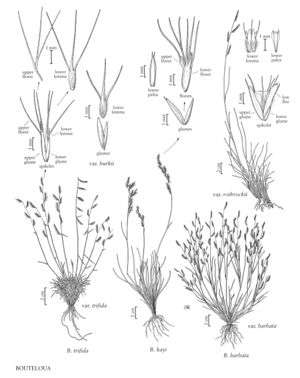Difference between revisions of "Bouteloua trifida"
FNA>Volume Importer |
FNA>Volume Importer |
||
| Line 17: | Line 17: | ||
-->{{Treatment/Body | -->{{Treatment/Body | ||
|distribution=N.Mex.;Tex.;Utah;Calif.;Ariz.;Nev. | |distribution=N.Mex.;Tex.;Utah;Calif.;Ariz.;Nev. | ||
| − | |discussion=<p | + | |discussion=<p>Bouteloua trifida grows on dry open plains, shrubby hills, and rocky slopes, at 2200-2500 m. Its range extends from the southwestern United States to central Mexico. It is a drought-resistant species that is some¬times mistaken for Aristida because of its delicate, cespitose growth habit and purplish, 3-awned spikelets. Juvenile plants may also be confused with B. barbata but that species is annual, with the central awn flanked by two membranous lobes and the lowest paleas 4-lobed and 2-awned.</p> |
|tables= | |tables= | ||
|references= | |references= | ||
| Line 47: | Line 47: | ||
|basionyms= | |basionyms= | ||
|family=Poaceae | |family=Poaceae | ||
| + | |illustrator=Linda A. Vorobik and Cindy Roché | ||
|distribution=N.Mex.;Tex.;Utah;Calif.;Ariz.;Nev. | |distribution=N.Mex.;Tex.;Utah;Calif.;Ariz.;Nev. | ||
|reference=None | |reference=None | ||
| Line 52: | Line 53: | ||
|publication year= | |publication year= | ||
|special status= | |special status= | ||
| − | |source xml=https:// | + | |source xml=https://bibilujan@bitbucket.org/aafc-mbb/fna-data-curation.git/src/314eb390f968962f596ae85f506b4b3db8683b1b/coarse_grained_fna_xml/V25/V25_888.xml |
|subfamily=Poaceae subfam. Chloridoideae | |subfamily=Poaceae subfam. Chloridoideae | ||
|tribe=Poaceae tribe Cynodonteae | |tribe=Poaceae tribe Cynodonteae | ||
Revision as of 16:18, 30 October 2019
Plants perennial; cespitose, older plants occasionally shortly rhizomatous. Culms 5-40 cm, slender, wiry, erect or slightly geniculate at the lower nodes; lower internodes glabrous, shorter than those above. Leaves mostly basal; sheaths glabrous, sometimes scabridu-lous, becoming flattened, persistent; ligules 0.2-0.5 mm, of hairs; blades 0.7-8 cm long, 0.5-1.5(2) mm wide, scabridulous, margins often with papillose-based hairs basally. Panicles 3-9 cm, with 2-7 branches; branches 7-25 mm, persistent, spreading, ascending, or appressed, straight to slightly arcuate, with 8-24(32) spikelets, axes terminating in a spikelet; disarticulation above the glumes. Spikelets appressed to pectinate, reddish-purple; with 1 bisexual floret and 1 rudimentary floret. Glumes bilobed; lower glumes 1.7-3.4 mm, slightly shorter than the upper glumes, veins excurrent to 0.6 mm; upper glumes 1.9-4 mm, glabrous or pubescent, hairs not papillose-based, veins excurrent to 1 mm; lower lemmas 1.2-2.2 mm, glabrous, sparsely appressed pubescent along the veins or densely appressed pubescent for much of their length and on the margins, trilobed, lobes veined, tapering into 3 awns, awns 2.2-6.6 mm, central awns not flanked by membranous lobes; anthers 0.2-0.4 mm, yellow; rachilla segments glabrous; upper florets glabrous, of 3 equal awns, awns 2-7 mm. Caryopses 0.8-1.5 mm long, 0.3-0.6 mm wide. 2n = 20.
Distribution
N.Mex., Tex., Utah, Calif., Ariz., Nev.
Discussion
Bouteloua trifida grows on dry open plains, shrubby hills, and rocky slopes, at 2200-2500 m. Its range extends from the southwestern United States to central Mexico. It is a drought-resistant species that is some¬times mistaken for Aristida because of its delicate, cespitose growth habit and purplish, 3-awned spikelets. Juvenile plants may also be confused with B. barbata but that species is annual, with the central awn flanked by two membranous lobes and the lowest paleas 4-lobed and 2-awned.
Selected References
None.
Key
| 1 | Lower lemmas densely appressed pubescent; awns 2.2-4.5 mm long; anthers 0.2-0.3 mm long | Bouteloua trifida var. burkii |
| 1 | Lower lemmas glabrous or sparsely appressed pubescent along both sides of the veins; awns (3.2)4-6.6 mm long; anthers 0.3-0.4 mm long | Bouteloua trifida var. trifida |
